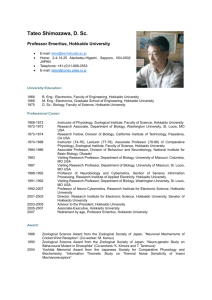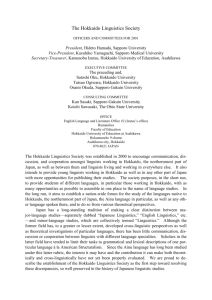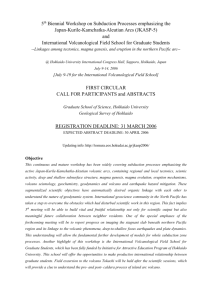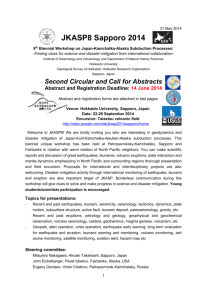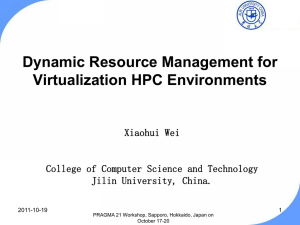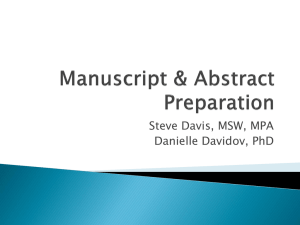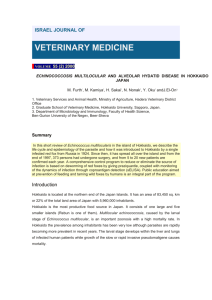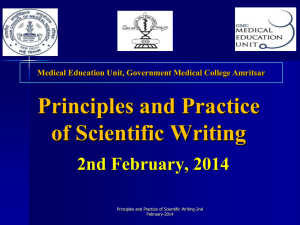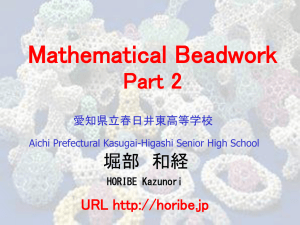12TH INTERNATIONAL CONFERENCE ON THE PHYSICS AND
advertisement
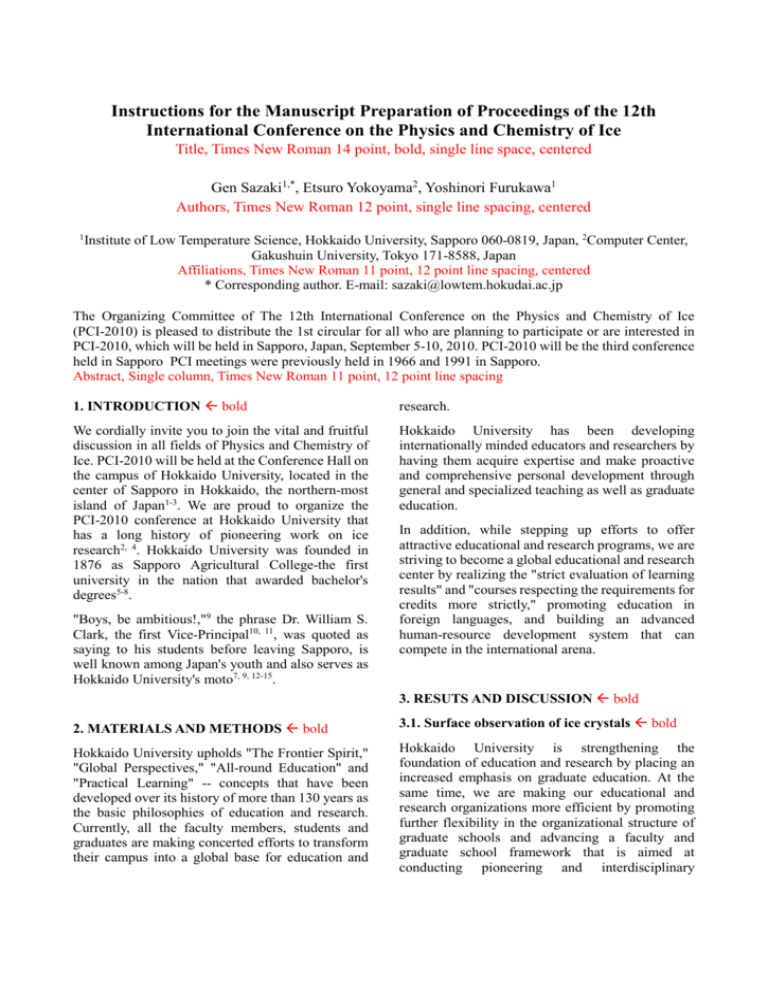
Instructions for the Manuscript Preparation of Proceedings of the 12th
International Conference on the Physics and Chemistry of Ice
Title, Times New Roman 14 point, bold, single line space, centered
Gen Sazaki1,*, Etsuro Yokoyama2, Yoshinori Furukawa1
Authors, Times New Roman 12 point, single line spacing, centered
1
Institute of Low Temperature Science, Hokkaido University, Sapporo 060-0819, Japan, 2Computer Center,
Gakushuin University, Tokyo 171-8588, Japan
Affiliations, Times New Roman 11 point, 12 point line spacing, centered
* Corresponding author. E-mail: sazaki@lowtem.hokudai.ac.jp
The Organizing Committee of The 12th International Conference on the Physics and Chemistry of Ice
(PCI-2010) is pleased to distribute the 1st circular for all who are planning to participate or are interested in
PCI-2010, which will be held in Sapporo, Japan, September 5-10, 2010. PCI-2010 will be the third conference
held in Sapporo PCI meetings were previously held in 1966 and 1991 in Sapporo.
Abstract, Single column, Times New Roman 11 point, 12 point line spacing
1. INTRODUCTION bold
research.
We cordially invite you to join the vital and fruitful
discussion in all fields of Physics and Chemistry of
Ice. PCI-2010 will be held at the Conference Hall on
the campus of Hokkaido University, located in the
center of Sapporo in Hokkaido, the northern-most
island of Japan1-3. We are proud to organize the
PCI-2010 conference at Hokkaido University that
has a long history of pioneering work on ice
research2, 4. Hokkaido University was founded in
1876 as Sapporo Agricultural College-the first
university in the nation that awarded bachelor's
degrees5-8.
Hokkaido University has been developing
internationally minded educators and researchers by
having them acquire expertise and make proactive
and comprehensive personal development through
general and specialized teaching as well as graduate
education.
"Boys, be ambitious!,"9 the phrase Dr. William S.
Clark, the first Vice-Principal10, 11, was quoted as
saying to his students before leaving Sapporo, is
well known among Japan's youth and also serves as
Hokkaido University's moto7, 9, 12-15.
In addition, while stepping up efforts to offer
attractive educational and research programs, we are
striving to become a global educational and research
center by realizing the "strict evaluation of learning
results" and "courses respecting the requirements for
credits more strictly," promoting education in
foreign languages, and building an advanced
human-resource development system that can
compete in the international arena.
3. RESUTS AND DISCUSSION bold
2. MATERIALS AND METHODS bold
3.1. Surface observation of ice crystals bold
Hokkaido University upholds "The Frontier Spirit,"
"Global Perspectives," "All-round Education" and
"Practical Learning" -- concepts that have been
developed over its history of more than 130 years as
the basic philosophies of education and research.
Currently, all the faculty members, students and
graduates are making concerted efforts to transform
their campus into a global base for education and
Hokkaido University is strengthening the
foundation of education and research by placing an
increased emphasis on graduate education. At the
same time, we are making our educational and
research organizations more efficient by promoting
further flexibility in the organizational structure of
graduate schools and advancing a faculty and
graduate school framework that is aimed at
conducting pioneering and interdisciplinary
strengthen cooperation with society.
Aiming to take more initiative and become more
self-reliant than ever, Hokkaido University
established the "Hokkaido University Frontier
Foundation" on the occasion of the 130th
anniversary of its founding in 2006, so that the
university would not only redouble its efforts but
also receive extensive support from enterprises,
individuals and alumni.
The 2D nucleation rate J 2D (i) of multi-layered
islands, where i is the number of layers, can be
expressed as follows3,4:
i G(1)
J 2D (i) C1 exp
.
kBT
(1)
Here is the attachment frequency of a monomeric
molecule to a critical nucleus, the Zeldovich
factor, C1 the density of monomeric molecules on a
crystal surface, G(1) the activation free energy
research and education.
barrier of the 2D nucleation of single-layered
Through such initiatives, we strive to create new (elementary) islands, kB the Boltzmann constant, T
the absolute temperature.
research bases with interdisciplinary projects,
provide lectures in foreign languages, and accept
The Hokkaido University Frontier Foundation aims
competent international students to further our
to make the
university contributable to local
development into a university open to the world and
communities and the international society. To this
a global center for education and research.
end, the Foundation will strive to improve
educational and research bases and, among other
Hokkaido University is developing a host of projects
things, conduct student support activities for the
intended to enhance public awareness of this
purpose of developing excellent human resources.
university: the utilization of the Tokyo and Beijing
Offices as the bases for transmitting information to
With your generous cooperation, Hokkaido
society and promoting exchange activities with local
University is committed to carrying out further
communities; the improvement of its websites and
visionary university reforms in upholding one of the
public relations magazines; public relations
university's fundamental philosophies -- the frontier
activities, including the Open Campus for high
spirit.
school students and the dissemination of
information on entrance examinations; the
organization of the Extension Lecture Programs;
4. SUMMARY bold
and the improvement of the Open Course Ware, in
which course materials are made available to the
Model barn of Hokkaido University in Sapporo, an
world.
important Cultural Property, was built in 1877,
Figure 1. A photomicrograph of a {110} face of a
tetragonal lysozyme crystal growing by the spiral
growth mechanism.
3.2. Quasi-liquid layers bold
In addition, we plan to further enhance and utilize
bases for joint projects and research with local
communities and industries, including the Creative
Research Initiative "Sousei" and the Management
Center for Intellectual Property and Innovation, to
share the fruits of our research activities and
based on Dr. Clark's belief that successful farming
depended on spacious stables to shelter animals
from severe winters. The barn was one of nine
buildings, including a silo, bull-house, milking shed,
and tool shed built in the style of 19th century
American barns. It was moved to the present site in
1910, and extensive restoration was carried out in
1977-79. There is a restroom located outside this
building.
ACKNOWLEDGMENTS bold
The authors thank T. Uchida of Hokkaido University
for valuable discussion.
REFERENCES bold
(1) Y. Furukawa, M. Yamamoto, T. Kuroda, J.
Cryst. Growth, 82, 665-677 (1987).
(2) Y. Furukawa, N. Inohara, E. Yokoyama, J.
Cryst. Growth, 275, 161-174 (2005).
(3) P.V. Hobbs, Ice Physics, Clarendon Press,
Oxford, 1974, p.346-347.
(4) A.A. Chernov, Challenges in Crystal Growth
Science and the Microgravity Tool, in: K. Sato,
Y. Furukawa, K. Nakajima (Eds.), Advances in
Crystal Growth Research, Elsevier, Amsterdam,
2001, p.62-77.
(5) S. Miyashita, K. Kurihara, K. Hasegawa, G.
Sazaki, T. Nakada, S.D. Durbin, H. Komatsu,
M. Fujishima, M. Koyama, Proc. 1st
Pan-Pacific Basin Workshop on Microgravity
Sciences, Tokyo, Japan, July 8-11, 1998,
p.577-581.
The manuscript should be camera ready. When the
manuscript is printed, its size is reduced to about
90%.
Figures and Tables should be embedded in the
appropriate position in the manuscript. If necessary,
the authors can fit their figures and tables into a
double column size.
All proceedings will be published in BLACK &
WHITE. Then if the manuscript contains color
figures, the authors should check their visibilities in
BLACK & WHITE.
2) Manuscript submission
The manuscript should be prepared in two file
formats: one is Microsoft word, and the other is pdf.
The latter will be used for checking the original
layout of figures and tables.
File names should be as follows:
(Registration number)_(Family name).doc
(Registration number)_(Family name).pdf
e.g. pci2010046_Sazaki.doc and
pci2010046_Sazaki.pdf
Instructions for manuscript preparation
The authors should send both (word and pdf) files to
the following e-mail address:
PCI-2010@lowtem.hokudai.ac.jp
as attached files.
1) Manuscript Format
Submission deadline: July 30, 2010.
Paper size: A4
The manuscript will be peer reviewed.
Margins: top 30 mm, bottom 35 mm, left 20 mm,
right 20 mm
Hokkaido University Press does not need copyright
transfer from the authors.
Column number: double
Font: Times New Roman, 11 point,
Line spacing: exactly at 12 point
Spacing before a paragraph break: 0 point
Spacing after a paragraph break: 6 point
Manuscript length:
# Plenary or Invited papers: maximum 10
camera-ready pages
# Oral or poster papers: maximum 8 camera-ready
pages
